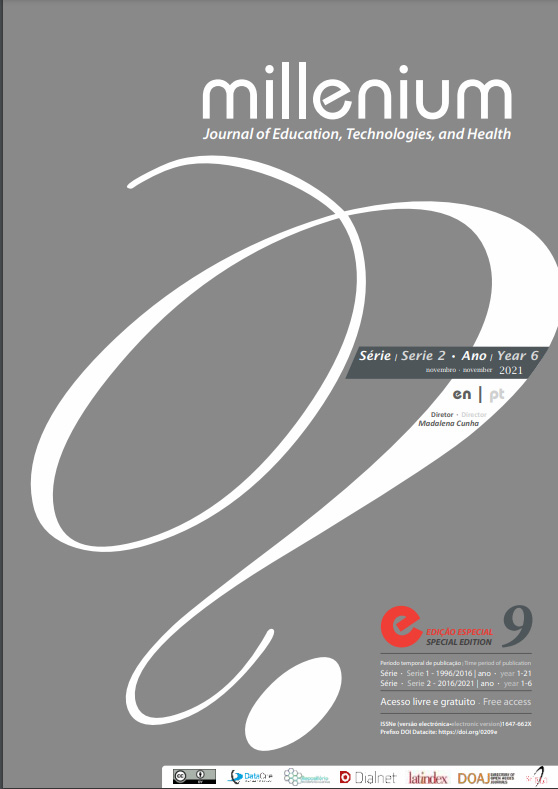Nursing care in the prevention of medical adhesive–related skin injuries
a scoping review
DOI:
https://doi.org/10.29352/mill029e.24981Keywords:
wounds and injuries, skin, nursing careAbstract
Introduction: Medical Adhesive-Related Skin Injuries (MARSI) can occur at any age, environment or body location where the medical adhesive is applied. This material is widely used in healthcare. It becomes urgent that nurse(s) implement preventative and effective measures against the injuries it produces.
Objetive: To map the nursing care used in the prevention of MARSI occurrences and identify existing gaps in the literature.
Methods: A scoping review was performed, according to the method proposed by Joanna Briggs Institute. Two independent reviewers performed the selection, extraction and synthesis of data.
Results: Eight studies with different methodologies were included for an enriching synthesis, demonstrating that the products used are effective in preventing MARSI injuries. Improvements in care are expected, since no reference to preventive nursing care, other than adjuvant products, was found.
Conclusion: The nurse plays a key role in the use of medical patches. The education of these professionals can contribute to the awareness of the risk of MARSI lesions, in order to promote the best practices. Although the possible adjuvant products to be used are known, there is little literature regarding nursing interventions to prevent these lesions.
Downloads
References
Britt, S. E., Coles, K. M., & Polson, S. S. (2017). Medical adhesive-related skin injury following emergent appendectomy: a case study of MARSI and missed opportunities in nursing care. Journal of Wound, Ostomy and Continence Nursing, 44(2), 188– 192. doi.org/10.1097/WON.0000000000000309
Chen, Y. H., Hsieh, H. L., & Shih, W. M. (2020). Applying skin barrier film for skin tear management in patients with central venous catheterization. Advances in skin and wound care, 33(11), 582–586. doi.org/10.1097/01.ASW.0000717208.20481.a0
Collier, M. (2019). Minimising pain and medical adhesive related skin injuries in vulnerable patients. British Journal of Nursing, 28(15), S26–S32. doi.org/10.12968/bjon.2019.28.15.S26
Farris, M. K., Petty, M., Hamilton, J., Walters, S. A., & Flynn, M. A. (2015). Medical adhesive-related skin injury prevalence among adult acute care patients. Journal of Wound, Ostomy & Continence Nursing, 42(6), 589–598. doi.org/10.1097/won.0000000000000179
Gao, C., Yu, C., Lin, X., Wang, H., & Sheng, Y. (2020). Incidence of and risk factors for medical adhesive-related skin injuries among patients: a cross-sectional study. Journal of Wound, Ostomy and Continence Nursing, 47(6), 576–581. doi.org/10.1097/WON.0000000000000714
Hadfield, G., Alexandra, De Freitas, B. S., Freitas, A. de, & Bradbury, S. (2019). Clinical evaluation of a silicone adhesive remover for prevention of MARSI at dressing change. Journal of Community Nursing, 33(3), 36–41. http://search.ebscohost.com/login.aspx?direct=true&db=edo&AN=137440549&site=eds-live
Hitchcock, J., & Savine, L. (2017). Medical adhesive-related skin injuries associated with vascular access. British Journal of Nursing, 26(8), S4–S12. https://doi.org/10.12968/bjon.2017.26.8.S4
McNichol L., Bianchi, J. (2016). MARSI made easy. Wounds UK, 12(4). https://www.wounds-uk.com/resources/details/medical-adhesive-related-skin-injuries-marsi-made-easy
McNichol, L., Lund, C., Rosen, T., & Gray, M. (2013). Medical adhesives and patient safety: state of the science consensus statements for the assessment, prevention, and treatment of adhesive-related skin injuries. Journal of Wound, Ostomy and Continence Nursing, 40(4), 365–380. https://doi.org/10.1097/WON.0b013e3182995516
Ratliff, C. R. (2017). Descriptive study of the frequency of medical adhesive–related skin injuries in a vascular clinic. Journal of Vascular Nursing, 35(2), 86–89. https://doi.org/10.1016/j.jvn.2017.01.001
Thayer, D. M., Rozenboom, B., & Baranoski, S. (2015). “Top-down” injuries: Prevention and management of moisture-associated skin damage (MASD), medical adhesive-related skin injury (MARSI), and skin tears. Wound, Ostomy and Continence Nurses SocietyTM Core Curriculum: Wound Management, 2015.
Tricco, A. C., Lillie, E., Zarin, W., O’Brien, K. K., Colquhoun, H., Levac, D., Moher, D., Peters, M. D. J., Horsley, T., Weeks, L., Hempel, S., Akl, E. A., Chang, C., McGowan, J., Stewart, L., Hartling, L., Aldcroft, A., Wilson, M. G., Garritty, C., … Straus, S. E. (2018). PRISMA extension for scoping reviews (PRISMA-ScR): Checklist and explanation. Annals of Internal Medicine, 169(7), 467– 473. https://doi.org/10.7326/M18-0850
Zhang, Y., Wang, S., Zhang, X., Zhang, W., & Wang, X. (2020). Incidence and influencing factors of medical adhesive-related skin injury in critically ill patients. Advances in Skin and Wound Care, 33(5), 260–266. https://doi.org/10.1097/01.ASW.0000658584.09988.fa
Zhao, H., He, Y., Huang, H., Ling, Y., Zhou, X., Wei, Q., Lei, Y., & Ying, Y. (2018). Prevalence of medical adhesive-related skin injury at peripherally inserted central catheter insertion site in oncology patients. Journal of Vascular Access, 19(1), 23–27. https://doi.org/10.5301/jva.5000805
Downloads
Published
How to Cite
Issue
Section
License

This work is licensed under a Creative Commons Attribution 4.0 International License.
Authors who submit proposals for this journal agree to the following terms:
a) Articles are published under the Licença Creative Commons (CC BY 4.0), in full open-access, without any cost or fees of any kind to the author or the reader;
b) The authors retain copyright and grant the journal right of first publication, allowing the free sharing of work, provided it is correctly attributed the authorship and initial publication in this journal;
c) The authors are permitted to take on additional contracts separately for non-exclusive distribution of the version of the work published in this journal (eg, post it to an institutional repository or as a book), with an acknowledgment of its initial publication in this journal;
d) Authors are permitted and encouraged to publish and distribute their work online (eg, in institutional repositories or on their website) as it can lead to productive exchanges, as well as increase the impact and citation of published work
Documents required for submission
Article template (Editable format)





